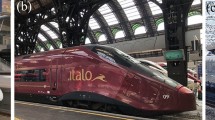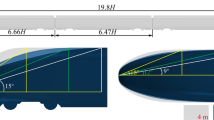Abstract
A numerical study using improved delayed detached eddy simulation (IDDES) was used to investigate the influence of the embankment height on the aerodynamic performance of a high-speed train travelling under the influence of a crosswind. The results of the flow predictions were used to explore both the instantaneous and the time-averaged flows and the resulting aerodynamic forces, moments and slipstreams. An increase of the aerodynamic drag and side forces as well as the lift force of the head and middle cars were observed with rising embankment height. While the lift force of the tail car decreased with the increasing embankment height. Furthermore, the height of the embankment was found to have a strong influence on the slipstream on the leeward side of the train. The correlation between the embankment height and the slipstream velocity on the windward side, was rather small. The flow structures in the near-wake of the leeward side of the train, responsible for the aerodynamic properties of the train were analyzed, showing strong dependency on the embankment height.















Similar content being viewed by others
References
Baker, C.J.: The flow around high speed trains. J. Wind Eng. Ind. Aerodyn. 98(6–7), 277–298 (2010)
Baker, C.J., Quinn, A., Sima, M., Hoefener, L., Licciardello, R.: Full-scale measurement and analysis of train slipstreams and wakes. Part 1: ensemble averages. Proc. Inst. Mech. Eng. Part F J. Rail Rapid Transp. 228(5), 451–467 (2014a)
Baker, C.J., Quinn, A., Sima, M., Hoefener, L., Licciardello, R.: Full-scale measurement and analysis of train slipstreams and wakes. Part 2: Gust analysis. Proc. Inst. Mech. Eng. Part F J. Rail Rapid Transp. 228(5), 468–480 (2014b)
Bell, J.R., Burton, D., Thompson, M., Herbst, A., Sheridan, J.: Wind tunnel analysis of the slipstream and wake of a high-speed train. J. Wind Eng. Ind. Aerodyn. 134, 122–138 (2014)
Bell, J.R., Burton, D., Thompson, M.C., Herbst, A.H., Sheridan, J.: Flow topology and unsteady features of the wake of a generic high-speed train. J. Fluids Struct. 61, 168–183 (2016)
Bell, J.R., Burton, D., Thompson, M.C., Herbst, A.H., Sheridan, J.: The effect of tail geometry on the slipstream and unsteady wake structure of high-speed trains. Exp. Therm. Fluid Sci. 83, 215–230 (2017)
Bocciolone, M., Cheli, F., Corradi, R., Muggiasca, S., Tomasini, G.: Crosswind action on rail vehicles: wind tunnel experimental analyses. J. Wind Eng. Ind. Aerodyn. 96(5), 584–610 (2018)
CEN European Standard: Railway Applications–Aerodynamics. Part 6: Requirements and Test Procedures for Cross Wind Assessment, CEN EN 14067–6 (2018)
Cheli, F., Ripamonti, F., Rocchi, D., Tomasini, G.: Aerodynamic behaviour investigation of the new EMUV250 train to cross wind. J. Wind Eng. Ind. Aerodyn. 98(4–5), 189–201 (2010a)
Cheli, F., Corradi, R., Rocchi, D., Tomasini, G., Maestrini, E.: Wind tunnel tests on train scale models to investigate the effect of infrastructure scenario. J. Wind Eng. Ind. Aerodyn. 98(6–7), 353–362 (2010b)
Chen, Z.W., Liu, T.H., Yan, C.G., Yu, M., Guo, Z.J., Wang, T.T.: Numerical simulation and comparison of the slipstreams of trains with different nose lengths under crosswind. J. Wind Eng. Ind. Aerodyn. 190, 256–272 (2019a)
Chen, G., Li, X.B., Liu, Z., Zhou, D., Wang, Z., Liang, X.F., Krajnović, S.: Dynamic analysis of the effect of nose length on train aerodynamic performance. J. Wind Eng. Ind. Aerodyn. 184, 198–208 (2019b)
Diedrichs, B., Sima, M., Orellano, A., Tengstrand, H.: Crosswind stability of a high-speed train on a high embankment. Proc. Inst. Mech. Eng. Part F J. Rail Rapid Transp. 221 (2), 205–225: (2007)
DIN Standards Committee: Railway/Normenausschuss Fahrweg und Schienenfahrzeuge (FSF) (2018)
European Union Agency for Railways: Commission Regulation (EU) No 1302/2014 concerning a technical specification for interoperability relating to the ‘rolling stock—locomotives and passenger rolling stock’ subsystem of the rail system (2014)
Flynn, D., Hemida, H., Soper, D., Baker, C.: Detached-eddy simulation of the slipstream of an operational freight train. J. Wind Eng. Ind. Aerodyn. 132, 1–12 (2014)
Flynn, D., Hemida, H., Baker, C.: On the effect of crosswinds on the slipstream of a freight train and associated effects. J. Wind Eng. Ind. Aerodyn. 156, 14–28 (2016)
Guo, Z.J., Liu, T.H., Chen, Z.W., Liu, Z., Monzer, A., Sheridan, J.: Study of the flow around railway embankment of different heights with and without trains. J. Wind Eng. Ind. Aerodyn. 202, 104203 (2020)
Hemida, H., Krajnović, S.: LES study of the influence of the nose shape and yaw angles on flow structures around trains. J. Wind Eng. Ind. Aerodyn. 98(1), 34–46 (2010)
Krajnović, S., Ringqvist, P., Nakade, K., Basara, B.: Large eddy simulation of the flow around a simplified train moving through a crosswind flow. J. Wind Eng. Ind. Aerodyn. 110, 86–99 (2012)
Li, X.L., Chen, G., Zhou, D., Chen, Z.W.: Impact of different nose lengths on flow-field structure around a high-speed train. Appl. Sci. Basel 9(21), 4573 (2019)
Luckhurst, S., Varney, M., Xia, H., Passmore, M.A., Gaylard, A.: Computational investigation into the sensitivity of a simplified vehicle wake to small base geometry changes. J. Wind Eng. Ind. Aerodyn. 185, 1–15 (2019)
Morden, J.A.: A Numerical Investigation of the Effects of Crosswinds Upon the Aerodynamic Characteristics of a High-Speed Passenger Train and Its Slipstream (Ph.D. thesis). The University of Birmingham (2016)
Muld, T.W., Efraimsson, G., Henningson, D.S.: Flow structures around a high-speed train extracted using proper orthogonal decomposition and dynamic mode decomposition. Comput. Fluids 57, 87–97 (2012)
Munoz-Paniagua, J., García, J., Lehugeur, B.: Evaluation of RANS, SAS and IDDES models for the simulation of the flow around a high-speed train subjected to crosswind. J. Wind Eng. Ind. Aerodyn. 171, 50–66 (2017)
Noguchi, Y., Suzuki, M., Baker, C.J., Nakade, K.: Numerical and experimental study on the aerodynamic force coefficients of railway vehicles on an embankment in crosswind. J. Wind Eng. Ind. Aerodyn. 184, 90–105 (2019)
Pope, C.: Safety of Slipstreams Effects Produced by Trains. A Report Prepared by Mott Macdonald Ltd. for Railway Safety and Standards Board, 2 edn. Mott MacDonald, Croydon (2006)
Schober, M., Weise, M., Orellano, A., Deeg, P., Wetzel, W.: Wind tunnel investigation of an ICE 3 end car on three standard ground scenarios. J. Wind Eng. Ind. Aerodyn. 98(6–7), 345–352 (2010)
Shur, M.L., Spalart, P.R., Strelets, M.K., Travin, A.K.: A hybrid RANS–LES approach with delayed-DES and wall-modelled les capabilities. Int. J. Heat Fluid Flow 29(6), 1638–1649 (2008)
Suzuki, M., Tanemoto, K., Maeda, T.: Aerodynamic characteristics of train/vehicles under cross winds. J. Wind Eng. Ind. Aerodyn. 91, 209–218 (2003)
Tomasini, G., Giappino, S., Corradi, R.: Experimental investigation of the effects of embankment scenario on railway vehicle aerodynamic coefficients. J. Wind Eng. Ind. Aerodyn. 131, 59–71 (2014)
Wang, S.B., Bell, J.R., Burton, D., Herbst, A.H., Sheridan, J., Thompson, M.C.: The performance of different turbulence models (URANS, SAS and DES) for predicting high-speed train slipstream. J. Wind Eng. Ind. Aerodyn. 165, 46–57 (2017)
Wang, S.B., Burton, D., Herbst, A.H., Sheridan, J., Thompson, M.C.: The effect of bogies on high-speed train slipstream and wake. J. Fluids Struct. 83, 471–489 (2018a)
Wang, S.B., Burton, D., Herbst, A.H., Sheridan, J., Thompson, M.C.: The effect of the ground condition on high-speed train slipstream. J. Wind Eng. Ind. Aerodyn. 172, 230–243 (2018b)
Xia, C., Wang, H., Shan, X., Yang, Z., Li, Q.: Effects of ground configurations on the slipstream and near wake of a high-speed train. J. Wind Eng. Ind. Aerodyn. 168, 177–189 (2017)
Zhang, J., Wang, J., Tan, X.M., Gao, G.J., Xiong, X.: Detached eddy simulation of flow characteristics around railway embankments and the layout of anemometers. J. Wind Eng. Ind. Aerodyn. 193, 103968 (2019)
Acknowledgements
This work was supported by the National Key R&D Program of China (2016YFB1200601-B14).
Author information
Authors and Affiliations
Corresponding author
Ethics declarations
Conflict of interest
The authors declare that they have no conflict of interest.
Rights and permissions
About this article
Cite this article
Li, X., Chen, G., Krajnovic, S. et al. Numerical Study of the Aerodynamic Performance of a Train with a Crosswind for Different Embankment Heights. Flow Turbulence Combust 107, 105–123 (2021). https://doi.org/10.1007/s10494-020-00213-2
Received:
Accepted:
Published:
Issue Date:
DOI: https://doi.org/10.1007/s10494-020-00213-2




